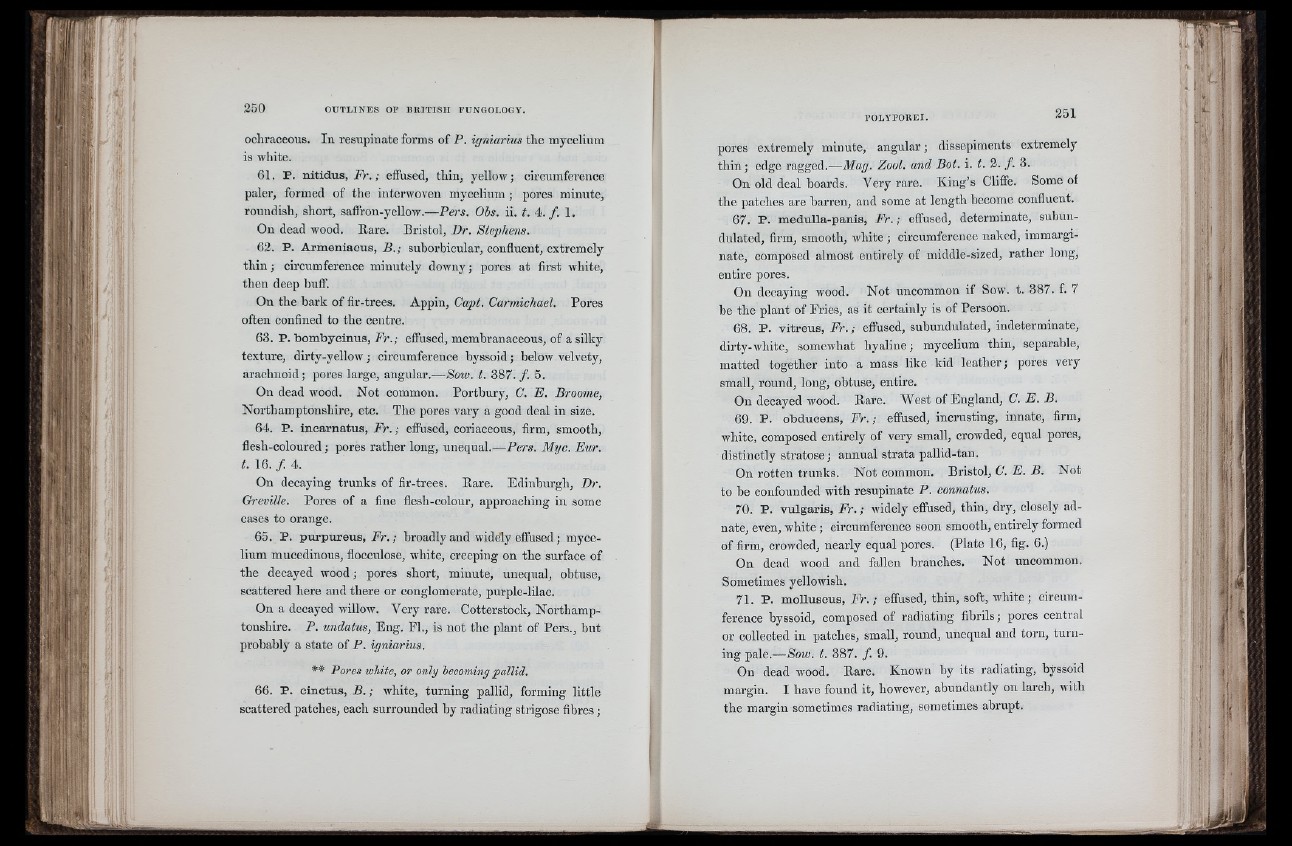
[ it . il
ochraceous. In resupinate forms of P. igniarius the mycelium
is white.
61. P. nitidus, F r .; effused, thin, yellow; circumference
paler, formed of the interwoven mycelium ; pores minute,
roundish, short, saffron-yellow.—Pers. Obs. ii. t. 4s. f . 1.
Ou dead wood. Rare. Bristol, Dr. Stephens.
62. P. Armeniacus, B.; suborbicular, confluent, extremely
tliin ; circumference minutely downy; pores at first white,
then deep buff.
On the bark of fir-trees. Appin, Capt. Carmichael. Pores
often confined to the centre.
63. P. bombycinus, Fr.; effused, membranaceous, of a silky
texture, dirty-yellow; circumference byssoid; below velvety,
arachnoid; pores large, angular.—Sow. t. 387. / . 5.
On dead wood. Not common. Portbury, C. E. Broome,
Northamptonshire, etc. The pores vary a good deal in size.
64. P. inearnatus, F r .; effused, coriaceous, firm, smooth,
flesh-coloured; pores rather long, unequal.—Pers. Myc. Eur.
t. 16. /. 4.
On decaying trunks of fir-trees. Bare. Edinburgh, Dr.
Greville. Pores of a fine flesh-colour, approaching in some
cases to orange.
65. P. purpureus, F r .; broadly and widely effused; mycelium
mucedinous, flocculose, white, creeping on the surface of
the decayed wood; pores short, minute, unequal, obtuse,
scattered here and there or conglomerate, purple-lilac.
On a decayed willow. Very rare. Cotterstock, Northamptonshire.
P. undatus, Eng. El., is not the plant of Pers., hnt
probably a state of P . igniarius.
** Pores white, or only becoming pallid.
66. P. einetns, B . ; white, turning pallid, forming little
scattered patches, each surrounded by radiating strigose fibres;
pores extremely minute, angular; dissepiments extremely
tliin; edge ragged.—Mag. Zool. and Bot. i. t. 2. f . 3.
On old deal boards. Very rare. King’s Cliffe. Some of
tlio patches are barren, and some at length become confluent.
67. P. medulla-panis, Fr.; effused, determinate, subun-
dulatcd, firm, smooth, white ; circumference naked, immargi-
nate, composed almost entirely of middle-sized, rather long,
entire pores.
On decaying wood. Not uncommon if Sow. t. 387. f. 7
be the plant of Eries, as it certainly is of Persoon.
68. P. vitreus, F r .; effused, subundulated, indeterminate,
dirty-white, somewhat hyaline; mycelium thin, separable,
matted together into a mass like kid leather; pores very
small, round, long, obtuse, entire.
On decayed wood. Bare. West of England, C. E. B.
69. P. obdueens, F r .; effused, incrnsting, innate, firm,
white, composed entirely of very small, crowded, equal pores,
distinctly stratose; annual strata pallid-tan.
On rotten trunks. Not common. Bristol, C. E. B. Not
to be confounded with resupinate P. connatus.
70. P. vulgaris, F r .; widely effused, thin, dry, closely adnate,
even, white; circumference soon smooth, entirely formed
of firm, crowded, nearly equal pores. (Plate 16, fig. 6.)
On dead wood and fallen branches. Not uncommon.
Sometimes yellowish.
71. P. moUnscus, F r.; effused, thin, soft, white; circumference
byssoid, composed of radiating fibrils; pores central
or collected in patches, small, round, unequal and torn, tui’ii-
ing pale.—Row. t. 387. / . 9.
On dead wood. Rare. Known by its radiating, byssoid
margin. I have found it, however, abundantly on larch, with
the margin sometimes radiating, sometimes abrupt. ■ i f
¡ P i
i l